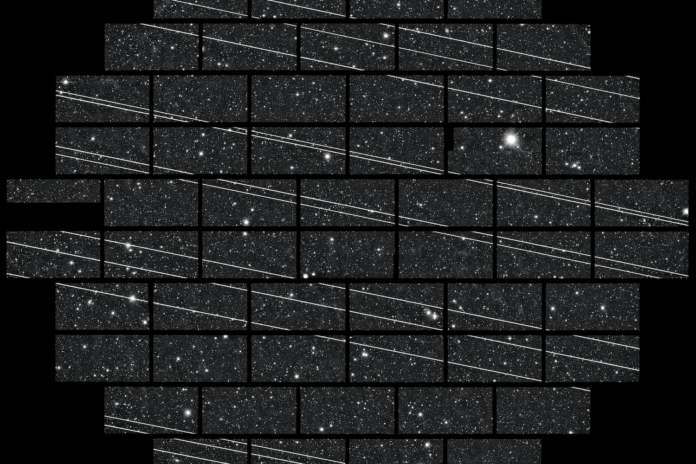SpaceX is working to make its satellites less of a nuisance to astronomers by testing ways to prevent Starlink from appearing on satellite images. The company recently lowered the height of a batch of its Internet satellites to reduce their brightness from Earth.
In a letter to the Federal Communications Commission (FCC), SpaceX said it has begun operating 300 of its satellites at lower orbital altitudes as part of the company’s efforts to reduce Starlink’s impact on optical astronomy. The company claims that the new method has been successful, resulting in a nearly 60% reduction in the number of sunlit satellites appearing in images taken by the telescope at the Vera Rubin Observatory in Chile.
Low Earth orbit is becoming increasingly cluttered with satellites, most of which belong to SpaceX. Currently, there are 6,912 Starlink satellites in orbit, located at an altitude of approximately 342 miles (550 kilometers) above the Earth’s surface. The orbiting satellites introduce unwanted noise into night sky observations by reflecting sunlight, which appears as streaks in images taken by ground-based observatories. The first Starlink satellites were very bright, making them visible to the naked eye and saturating the lenses of telescopes pointed in their direction.
In December 2022, the FCC granted SpaceX permission to launch up to 7,500 next-generation Starlink satellites, which are larger and brighter than their predecessors. The first generation of Starlink weighs about 573 pounds (260 kilograms), but future versions are much larger at 2,755 pounds (1,250 kg) and are therefore estimated to be about a full magnitude brighter than the OG satellites.
SpaceX is working with the National Science Foundation (NSF) to reduce the impact of its next-generation satellites on optical astronomy. The company recently lowered the altitude of its Starlinks demonstrators to 217 miles (350 km) above the Earth’s surface, reducing their ability to capture and reflect sunlight.
“SpaceX’s analysis also demonstrates that peak brightness from nadir surfaces only slightly increases when operating at 350 km [217 miles] due to the greater proportion of eclipse and angular velocity,” the company said in a letter. In other words, SpaceX argues that the brightness of the satellites’ reflectivity, when viewed from below, does not increase much at lower altitudes because they spend more time in the Earth’s shadow and move faster across the sky.
NSF agrees that this strategy could help. Lower orbits can “be beneficial for ground-based optical and infrared astronomy because the satellites move faster through the focal plane of the telescope and are more defocused, reducing the overall brightness per pixel,” an NSF spokesperson told Gizmodo in an email. “At lower altitudes, the satellites are also blocked from sunlight by the Earth for most of the night, preventing it from reflecting to the ground.” This allows the satellites to remain dimmer than about 7th magnitude – the threshold for naked-eye visibility – for most of the night, the spokesman explained.
There have been previous attempts to reduce the impact of Starlink on astronomical observations. SpaceX has worked with the International Astronomical Union and its Center for the Protection of Dark and Quiet Skies from Satellite Constellation Interference to find the main source of its satellites’ reflectivity and develop strategies to reduce it. As a result, the company changed the orientation of the satellites and their solar panels, and installed canopies to reduce their brightness.
This recent modification of the satellites’ orbits is still being evaluated, as it may have some drawbacks. “There are tradeoffs: satellites at lower altitudes may be brighter at dusk and affect science that requires twilight observations, such as studies of near-Earth objects,” the NSF added. The foundation will continue to work with SpaceX over the next year to see if the mitigation measures are working as planned.
SpaceX isn’t the only one launching satellites into orbit, and the growing amount of equipment cluttering Earth’s orbit could further obscure our view of space unless more companies commit to reducing their interference with astronomy.









